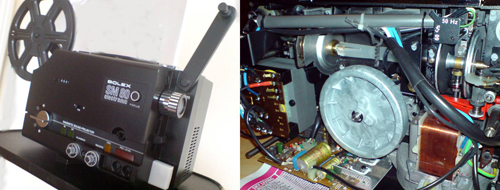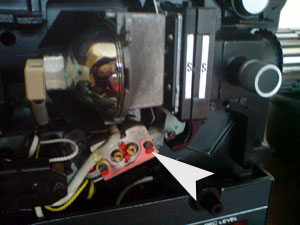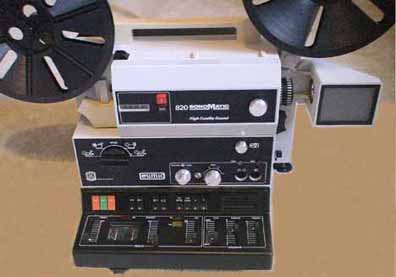This is topic PROJECTOR REVIEW in forum 8mm Forum at 8mm Forum.
To visit this topic, use this URL:
https://8mmforum.film-tech.com/cgi-bin/ubb/ultimatebb.cgi?ubb=get_topic;f=1;t=006100
Posted by Lee Mannering (Member # 728) on March 21, 2011, 10:50 AM:
I was not certain if we had ever started a series of posts on here looking at some of our favourite movie projectors or not, so if one is already up and running forgive my enthusiasm for the following machine.
BOLEX SM80 ELECTRONIC
Iím sure we all have our favourite Super 8 projectors in mind but I have a great affection for the little Bolex SM80 Electronic machine. Introduced in 1975 it was essentially a deluxe Eumig although licensed with the Bolex brand name and decorated in a delightful black paint job. I say deluxe as the Bolex versions were very much aimed at the discerning film maker who valued the name attached to the machine. At the time the SM80 and its smaller brother SP8 looked quite futuristic with its eggshell paint job, illuminating function lights and not least its F1.2 zoom lens so quite a sight at any 70ís film evening I can tell you. Of course the giveaway it was produced by Eumig was the second the mains plug was connected and we heard the familiar sound of the motor ticking over, also drawing air through the machine cooling the lamp. But the Bolex SM80 was not quite like any Eumig as it had some interesting tweaks up its relatively small sleeve. Amazingly the manufacture brief was to add even more electronics to this beastie to the point that when you change speeds from 18 to 24fps two indicator lamps light so you can see which speed you are running at in the dark. The machine also had a series of red LEDís which illuminate to give you an indication of recording levels which is a handy feature when using manual level for recording. A 4 digit frame counter was also included and interestingly the machine was twin track, with the track switch accessible externally to enable changing tracks without removing the lamp house cover. It also has a socket to the rear to enable double system connection for external tape deck so ideal for the film maker as well. The fitted as standard 1.2 multicoated lens delivers a good performance and in my time I have projected onto a 8ft screen without problem in a dark hall, and all that from a 100 watt lamp. Sound quality from these machines I found to be good and my Bolex machines still produce good sound today with no audible loss of level due to any kind of head wear, after all these machines are now 36 years old or there abouts. Incidentally my thoughts on Eumig or Bolex machines having soft audio heads is not that of the masses as I have yet to experience any problems. This could be partly due to my using tape splices as soon as they became available instead of cement which bashes the living daylights out of a sound head being near double the thickness when spliced together with cement. Another useful feature was a public address facility and of particular use when a lamp blows or you want to tell your audience to settle down. With a 600ft spool capacity, 15 watt audio amplifier and a nice 3 watt pilot light which switches off when you start projection the Bolex SM80 Electronic is a nice little machine which I am sure, certainly in my case has stood the test of time. Its no Elmo GS1200 or ST1200 for that matter should that be what tickles your fish, but value for money it packs a nice little punch pound for pound and a delight to use. Just to top it off they also incorporated a two pin claw on this model which give a nice steady picture instead of the usual single pin type. As you can see I am rather fond of the SM80 and also its bigger brother SM80 Programmatic with even more features. Yes all similar to some of the later Eumig machines but with just a little more features to temp you.
Photo: Left the Bolex SM80 Right Inside the back cover

Posted by Winbert Hutahaean (Member # 58) on March 21, 2011, 11:18 AM:
Hi Lee,
Thanks for posting this. But wouldn't that be good to identify the projector brand and model in the subject title? so people can easily find out his interest.
Later, Doug (or Moderator) can make a sticky post to put indexation of those reviews. This is similar to what we have done in Print review.
Just my 2 cents,
Posted by Steve Klare (Member # 12) on March 21, 2011, 11:44 AM:
I have the SP-80 Special which is very similar to this machine. It was my first sound projector and I suspect if it goes under someday it will actually join the "honored dead" among my movie equipment rather than join the parts pile.
Mine has been a steady performer for 9 years now, but I have a couple of gripes with it:
1) The sound head is difficult to clean, alhough it seems to stay clean on its own.
2) The grounding connection is not directly to the machine frame, which can make connecting it to external audio equipment...interesting.
3) The famous Eumig variable speed drive disk issue, which is probably what will kill this one in the end. I think this is a really clever design, and well built too. Unfortunately 30+ years down the road it has become a weakness.
Lee, your comments about the two pin claw are interesting. I always assumed mine was single pin because #2 had been broken off. Is one pin more the usual for Eumig 8XX machines?
Posted by Lee Mannering (Member # 728) on March 21, 2011, 12:29 PM:
Hello Steve. Yes the single pin is usual on the dual gauge Eumig machines.
Movie Maker magazine did a great test report on the SM80 over four pages long and worth reading. They said ďThe whole machine is well engineered with a satisfyingly good standard of design that comes from many years of developmentĒ. By the way Steve if the main drive discs start acting up clean them with a little Isopropyl alcohol and also the main drive wheel. You will find it brings the drive back to life! Recording wise I have had no problems pleased to say and made up my own cables. Cleaning the sound head on the Bolex or Eumig is a dream and what I have done in the past is tag some quarter inch reel to reel cleaning tape onto the end of some 8mm leader. Feed it into film path under the gate, put a few drops of head cleaning fluid onto the tape, put main switch to sound project NOT MAINS POWERED and inch the cleaning tape through it a few times. Simples!
SP80 Special was produced you may know just before the SP80 Electronic also has a part silver body. On paper yours could be up to 38 years old but still not out yet.
Winbert.
If the mods see this posting working I am sure they will set up as previously with my what you watching tonight.
Happy projecting one and all!
Posted by Steve Klare (Member # 12) on March 21, 2011, 01:45 PM:
Paul Adsett did a write-up some years ago on cleaning the Eumig heads which involves a minor tear down, but gets you right to the scene of the crime. The first time I did it it was a little intimidating (...The idea accidentally misaligning the head was scary.), but ever since then it's become no big deal.
I do it once or twice a year and haven't ever found anything horrific going on in there. For some reason I can't explain the insides of this machine stay a lot cleaner than the Elmos.
I've done the isopropyl clean a few times. Every so often there is a little slippage on startup but then a full recovery for months or even years. When it happens I think "Oh, no! Here it comes!". (-but then it goes!)
Do you have the carrying case with the built in external speaker?
Posted by Lee Mannering (Member # 728) on March 22, 2011, 03:34 AM:
Hi Steve. Ah the luxury of the speaker carry case which sadly I do not have. Think in the 70ís I did a head clean on a Eumig for someone taking the head unit apart but afterwards got told the sprung retaining clip was set at a certain pressure so should not be un screwed hence the red paint marker. Seem to vaguely remember also trying to stick some reel to reel head cleaning tape to film with a very thin double sided tape as well to run though a Eumig. We must have had a go at all sorts of things in our time but its all part of the fun with film.
The SM80 Electronic pictured is the favourite one in my collection and is completely un-marked possibly partly due to the superb paint job. Another plus with these machines is that they are compact so donít take up a large space when storing if you have another backup machine and they certainly donít break your back carrying them which is starting to get a factor as we get a little older. Also its nice to be able to completely remove both sides of the gate to keep spotless thus protecting our valued films. Yup like you I donít see a great deal of dust in the film path, but there again the film only has four points of contact through the mechanism which is probably why. Nice little machine which will probably see us out as wellÖ

Posted by Steve Klare (Member # 12) on March 22, 2011, 08:07 AM:
This is what Mr. Adsett wrought on the subject of internally cleaning Eumig heads:
"FOR A THOROUGH CLEAN, THIS PROCEDURE TAKES ABOUT 30 MINUTES, AND REQUIRES DISSASSEMBLY OF THE SOUND HEAD).
1. Set the control knob to the Forward position then pull off the black control knob at the side of the projector. Remove the lamp housing cover.
2. Pull off the volume control knob and the mixing control knob.
3. Undo the screw located between the volume control knob and the mixing knob, and pull the side panel forward and out to expose the inside of the projector.
4. Unplug the sound head, then undo the single screw which bolts the sound head to the chassis wall.
5. Remove the sound head.
6. Look at the sound head. There are a total of 6 screws in view. Do NOT touch the four innermost screws, they are used for the critical elevation and azimuth alignment of the sound head to the magnetic tracks on the film. Undo the 2 outer screws to remove only the MU-METAL magnetic shield, and the pressure pad assembly. You now have total access to the heads and pressure pads for a thorough cleaning with alcohol. Be very gentle in wiping the head areas. You may wish to de-magnetize the heads while you are at it, using a Radio Shack tape- head demagnetizing probe. Also polish the film channel and pressure pads with Pledge or Favor furniture polish.
7. After cleaning, reassemble the mu-metal shield and pressure pad assembly to the head, and tighten down the 2 outermost screws.
8. Align locating hole on the sound head with the pin in the chassis, and bolt back into place with the single screw. Plug the sound head back into the wall connector.
9. Reassemble the side panel, audio knobs, and Main control knob. Return the control knob to the OFF position."
This is quite a process, but the neat thing about it is is esposes the inside of the sound head so it can be cleaned directly. Obsviously it can't be done on the fly like the typical Elmo, but it takes away the worry of leaving something nasty behind because we can't see it.
[ March 22, 2011, 09:47 AM: Message edited by: Steve Klare ]
Posted by Paul Adsett (Member # 25) on March 22, 2011, 04:28 PM:
Thanks for that great test report Lee. I agree with Steve that the Eumig's seem to stay noticeably cleaner than the Elmo's, for whatever reason. They are great little machines, perfect design for home use, somehow making the Elmo's seem a little big and clumsy in comparison. Stick an f1.0 lens on one of them and you really have a great performing projector. Still, the 930 and up Eumigs are much better performers, even though they don't have that compact, rugged beauty of the 800's.
I have always wished that Eumig had developed a stereo version of the 800's, complete with an outboard mixing console like the 938 stereo:

I did a test report on the Eumig 938 Stereo for this forum, so if Doug wants to start a projector test report section, my report can be pulled over and added to Lee's.
Visit www.film-tech.com for free equipment manual downloads. Copyright 2003-2019 Film-Tech Cinema Systems LLC

UBB.classicTM
6.3.1.2


